World Tariff Profiles 2016World Tariff Profiles, a joint publication of the World Trade Organization (WTO), International Trade Centre, and the United Nations Conference on Trade and Development, provides comprehensive information on tariff parameters imposed by the 164 WTO members—including Bangladesh, India, Maldives, Myanmar, Nepal, and Sri Lanka— and other countries and Customs territories with available data on imports—including Bhutan, a WTO Observer. It contains individual country tariff profiles, and statistics on non-tariff measures in effect as of December 2015. This 2016 edition also contains a discussion of the 2017 Harmonized System, which will affect around 15% of goods traded globally. Author: World Trade Organization, International Trade Centre, and the United Nations Conference on Trade and Development Year: 2016 Download Tags: Tariff, Trade Facilitation, Customs For a Shared Future of South Asia: Trade Insight, Vol. 12, No. 3This volume focuses on the South Asian Association for Regional Cooperation (SAARC) as a means for fostering regional cooperation to increase stability and development in the region. It urges SAARC member countries to cooperate, highlighting how economic integration and involving non-state actors can strengthen overall cooperation in South Asia, and help secure regional peace and security. It includes a discussion on the Bangladesh-Bhutan-India-Nepal as an economic corridor, South Asian drivers of regional integration, and the Belt and Road initiative. Author: South Asia Watch on Trade, Economics, and Environment Year: 2016 Download Tags: SAARC, Regional Cooperation, BBIN Study for Development of a Potential Hydropower Plant in South AsiaRapid development in South Asia has produced a huge surge in energy demand. Nepal, with more than 83,000 megawatts of potential hydropower supply, can significantly increase the South Asian Association for Regional Cooperation (SAARC) region's energy security. This study highlights ongoing hydropower projects in Nepal, in particular, the Sunkoshi 2 Storage Project, which has the potential to become a regional hydropower plant in South Asia. It also emphasizes the need to expand the region's power transmission infrastructure to promote power trade, and updating of policies that govern cross-border electricity trade among countries in the region. Author: SAARC Energy Centre Year: 2016 Download Tags: Hydropower, Energy, Nepal, SAARC, Trade BIMSTEC: The Road AheadThis report examines how the Bengal Initiative for Multi-Sectoral Technical and Economic Cooperation (BIMSTEC) region can utilize its intraregional network to deepen regional cooperation and integration to better the lives of the roughly 1.5 million people living in this region. It discusses issues of trade, investment, regional value chains, and connectivity, in the context of making the BIMSTEC grouping more relevant and meaningful. With BIMSTEC's enormous potential waiting to be tapped, this report urges the grouping to take advantage of newly available opportunities and harvest low
hanging fruits, including establishment of a BIMSTEC power trade network,
promotion of business-to-business and people-to-people contact, enhancement of
regional value chains, and engaging the experience and expertise of BRICS
economies. Author: Research and Information System Year: 2016 Download Tags: BIMSTEC, Regional Cooperation, Thailand, Trade, Energy Paperless Trade in Regional Trade AgreementsThis working paper provides a comprehensive list of paperless trade measures in regional trade agreements, which have become more extensive, covering increasingly specific areas including certificate of origins and sanitary and phytosanitary certificates. It also confirms that the number of paperless trade measures have doubled between 2005-2008 and 2013-2016 at the global level, with regional trade containing more provisions than those featured in the World Trade Organization's Trade Facilitation Agreement. It introduces the new United Nations Treaty and Framework Agreement on Cross-Border Paperless Trade in Asia and the Pacific, which aims to become a tool for harmonized implementation of paperless trade provisions. Author: Yann Duval and Kong Mengjing Year: 2016 Download Tags: Paperless Trade, Sanitary and Phytosanitary Measures, Trade Facilitation, India Trade Facilitation and Global Value Chains: Opportunities for Sustainable DevelopmentThis paper analyzes the relationship between global value chains (GVCs) and trade facilitation, and its contribution to sustainable development outcomes on low-income and least developed countries (LICs and LDCs). A key insight of the paper concludes that it is not fundamentally GVCs that drive the sustainable development implications of improved trade facilitation, but the resulting extension and intensification of economic activity. It underlines the importance of putting in place domestic regulatory infrastructure that considers the appropriate economic, social, and environmental dimensions to ensure that GVCs remain consistent with the global commitment to sustainable development, while expanding economic opportunities of LICs and LDCs. Author: Ben Shepherd Year: 2016 Download Tags: Trade Facilitation, Trade, Global Value Chains, Sustainability, Sustainable Development, Least Developed Countries, LDC 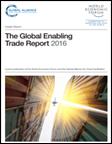 Global Enabling Trade Report 2016The Global Enabling Trade Report has been created to provide insight into trade policy and practice. It includes the Enabling Trade Index (ETI), which assesses the extent to which economies have in place institutions, policies, infrastructures and services facilitating the free flow of goods over borders and to their destination. This edition highlights that while an increasingly globalized trading system has been lifting millions out of poverty, trade barriers and costs are still preventing millions of people around the world from engaging in international trade. It reports that all South Asian economies have improved their ETI score over the past two years, with Bhutan as the most improved country in the region, jumping 12 places to 92, followed by India at 102, Sri Lanka at 103, Nepal at 108, Pakistan at 122, and Bangladesh at 123, yet the region remains the most closed worldwide. While South Asia has improved its access to foreign markets and adoption of ICTs, it needs to improve access to its domestic market – on average, South Asian countries impose a tariff of 16.7% on imported products – and enhance its transport infrastructure, particularly in Bhutan and Nepal. Author: Global Alliance for Trade Facilitation and the World Economic Forum Year: 2016 Download Tags: Trade, Trade Facilitation, Transport, Trade Policy, World Economic Forum, Bangladesh, Bhutan, India, Sri Lanka, Pakistan 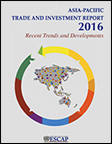 Asia-Pacific Trade and Investment Report 2016: Recent Trends and DevelopmentsThe Asia-Pacific Trade and Investment Report 2016 reports that the Asia-Pacific region is still the largest exporter of goods globally, with a share of 40%. Its share in commercial services trade is also on the rise, while restrictiveness of services trade has not increased. Foreign direct investment (FDI) inflows is also growing at a much faster pace compared to the global average, with special economic zones being used as one of the modalities to attract FDI. India, in particular, has been attracting an increasing portion of FDI inflows, both from outside and inside the region. While economies in Asia and the Pacific continue to make progress toward trade facilitation, there are still huge gaps among subregional economies, with much needing to be done to reduce trade costs. Furthermore, efforts undertaken to reduce trade costs through trade facilitation have been partially offset by imposition of a large number of new trade distortive measures globally and regionally, with most of these new measures falling under the non-tariff category. Author: United Nations Economic and Social Commission for Asia and the Pacific Year: 2016 Download Tags: Export, Trade Facilitation, Non-Tariff Measures, FDI, South Asia, India, Special Economic Zones Research Handbook on Trade in ServicesThis Research Handbook explores the latest developments in services trade by drawing on insights from experts with a range of perspectives, including empirical economics, law and global political economy. The book further chronicles the rising stakes and involvement of developing countries in global services trade, notably their growing insertion in global value chains, as well as the latest advances and remaining challenges in the statistical measurement of trade in services. Author: Pierre Sauvé and Martin Roy, editors Year: 2016 Download Tags: Services, Trade, Economics, Trade Facilitation, Trade Policy Economic Benefits from Nepal-India Electricity TradeThis report confirms Nepal and India's viable electricity export potential, and highlights how facilitating cross-border trade of electricity will benefit both countries. In Nepal, substantial economic gains can boost the economy and improve the well-being of its people—in 2045 under the accelerated power trade scenario, electricity trade revenue can bring in up to $9.8 billion. In India, gains from cross-border trade centers on lower electricity system cost—hydropower imports from Nepal will allow India to forgo some investment needed to meet its capacity demand. Furthermore, hydropower will complement India's solar and wind power generation, offering an affordable and convenient renewable resource to meet its evening peak demand. Author: South Asia Regional Initiative for Energy Integration Year: 2016 Download Tags: Energy, Trade, India, Nepal, Hydropower Capital Market Integration in South AsiaThis book discusses the potential capital market products and activities within South Asia that stakeholders in the region could explore to help the South Asian Association for Regional Cooperation (SAARC) region further realize its potential. Conventional investment, such as funds, global depository receipts, as well as promising opportunities that factor the region's demographics and socioeonomics are considered in this book, with arguments aimed toward investors and institutions. The book demonstrates both retail and institutional investor interest in this combined high-growth region by offering scope for yield, diversification and risk mitigation, maximized upside from multiple growth markets, minimized downside through low-correlation constituents, and makes the case why now is an opportune time to look at SAARC. Author: Sourajit Aiyer Year: 2016 Download Tags: Investment, SAARC, Trade, Economic Corridor 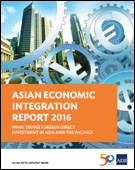 Asian Economic Integration Report 2016: What Drives Foreign Direct Investment in Asia and the Pacific?The 2016 Asian Economic Integration Report reviews regional economic cooperation and integration in Asia and the Pacific, amidst the rising global uncertainty following the United Kingdom’s referendum on leaving the European Union and the U.S. election, slower-than-expected global economic recovery, and ongoing economic restructuring in the People’s Republic of China and growth moderation. Asia faces heightened uncertainty–trade growth decelerated in 2015, falling to 2.3% in 2015; subregional trade linkages continue to strengthen, but inter-subregional trade linkages weakened; and non-tariff measures have become major obstacles to trade. In South Asia, SASEC cooperation has improved access to key markets in smaller economies, reduced real trade costs and behind-the-border barriers to stimulate investment; and enabled cross-border power exchanges to ensure power supply affordability, reliability, and overall grid stability. However, the SASEC agenda needs to be framed within wider integration processes taking place in Asia in the next decade to enhance economic linkages, and harness the full potential of Asian integration. Author: Asian Development Bank Year: 2016 Download Tags: ADB, ASEAN, Asia-Pacific, Development, FDI, Free Trade Agreements, Regional Cooperation, Regional Integration, SASEC, Trade Facilitation, UNCTAD, Bangladesh, Bhutan, India, Maldives, Nepal, Sri Lanka Competitiveness of South Asia’s Container Ports: A Comprehensive Assessment of Performance, Drivers, and CostsAs a result of inefficiencies in South Asia’s container ports, the average cost of exporting or importing a container in the region is more than double that in East Asia. Better port logistics could help increase trade, diversify exports, attract more foreign direct investment, and spur economic growth. As container traffic continues to grow in South Asia, the best way to improve port performance is by increasing productivity. This report examines the performance of the 14 largest container ports in the region, identifying key drivers of port performance and examining differences in performance across ports. Author: Matías Herrera Dappe and Ancor Suárez-Alemán Year: 2016 Download Tags: Customs, Economic Growth, FDI, Infrastructure, Investment, South Asia, Trade, WB Connecting Bangladesh: Economic Corridor NetworkEconomic corridors anchored on transport connectivity could significantly boost Bangladesh's economic growth. This paper presents a new set of corridors for Bangladesh – a nine-corridor comprehensive integrated multimodal economic corridor network that will enhance Bangladesh’s role as land bridge between South Asia and Southeast Asia, and between South Asia and northern Asia. These proposed corridors are designed to sustain robust economic growth over the long term by improving regional connectivity, transit, and integration, alongside trade facilitation measures. Author: Mohuiddin Alamgir Year: 2016 Download Tags: Economic Corridor, Bangladesh, South Asia, Southeast Asia, Connectivity, Transport, Trade Facilitation, ADB RCI Leveraging Urbanization in South Asia: Managing Spatial Transformation for Prosperity and LivabilityAs South Asian economies improve, they have the potential to greatly improve their prosperity and livability for the people of the region by improving their state of urbanization. Messy and hidden urbanization that leads to slums and sprawls is the result of failure to address congestion constraints arising from rapid growth of urban populations. This book examines the state of South Asia's urbanization – it reviews gaps in markets and policies that have hindered its proper growth, and discusses key policy areas that must be undertaken, including improvement in housing provisions, infrastructure, and basic services. Author: Peter Ellis and Mark Roberts Year: 2016 Download Tags: Economic Corridor, Urban Development, Governance, Sustainability, South Asia, Social Services SME Competitiveness Outlook: Meeting the Standard for TradeStandards and regulations for goods and services are important to international trade and value chains. They ensure consumer protection, determine compatibility, and promote environmental sustainability. This SME Competitiveness Outlook focuses on helping small and medium-sized enterprises (SME) make the most of standards and regulations to increase their competitiveness. Findings include strategies for SME managers on selecting and implementing standards and regulations, and an action plan for policymakers and trade and investment support institutions involved in aiding SMEs compete in markets where standards and regulations matter. Author: International Trade Centre Year: 2016 Download Tags: Trade, Small and Medium Enterprises, Bangladesh, India, Nepal, Sri Lanka, WTO, Global Value Chains World Trade Report: Levelling the Trading Field for SMEsParticipation in international trade, once exclusive, can progressively become more inclusive. But while new opportunities are opening up for small to medium-sized enterprises (SMEs), old barriers to international trade remain. This report highlights national and international policy actions that would enhance the ability of SMEs to participate in world markets more effectively. It says that for open trade and global integration to fully benefit everyone, it is crucial to ensure that all firms—not just large corporations—can succeed in today’s global marketplace. Author: World Trade Organization Year: 2016 Download Tags: Trade, WTO, Small and Medium Enterprise, Global Value Chains Implementing the Trade Facilitation Agreement: From Vision to RealityLow income to upper-middle income countries stand to gain a 14.6% to 16.5% reduction in trade costs upon implementation of the World Trade Organization's (WTO) Trade Facilitation Agreement (TFA). This publication looks at progression of the TFA – from conclusion of the talks at the 2013 Bali Ministerial Conference to preparations for the Agreement to take effect, as the valedictory moment of the TFA's entry into force nears. It highlights milestones, discusses the state of the ratification process, reviews implementation schedules, and examines work still to be done. Author: Nora Neufeld Year: 2016 Download Tags: Trade Facilitation, WTO, Least Developed Countries, Import, Export Trade Costs and Inclusive Growth: Case Studies Presented by WTO Chair-holdersThese contributions from participants of the World Trade Organization (WTO) Chairs Programme—which supports trade-related activities by academic institutions in developing countries—offer insightful research on opportunities that open up for developing countries when trade costs are reduced. Analyzing the potential impact of the WTO Trade Facilitation Agreement implementation in various developing regions of the world, this publication offers detailed country-level analysis on benefits of trade facilitation, including export diversification, greater global value chain participation, insertion of SMEs into international trade, the attraction of more foreign direct investments, and better governance. Author: Robert Teh, Maarten Smeets, Mustapha Sadni Jallab and Fatima Chaudhri, editors Year: 2016 Download Tags: Trade Facilitation, Global Value Chains, Small and medium enterprises, FDI, Governance, WTO South Asia Economic Focus, Fall 2016: Investment Reality CheckSouth Asia continues on a path of gradual acceleration in 2016, led by a solid India. However, amid the resilience to external headwinds, including China’s slowdown and uncertainty surrounding monetary policy in advanced economies, South Asia is starting to feel the effect of slowing remittance flows or waning oil price dividends. Against this backdrop, this World Bank publication forecasts growth for the region at 7.1% in 2016, with its medium-term performance strongly dependent on investment and export turnout. India is set to grow at 7.6% in 2016, with the same speed as in 2015, but may increase its pace again in 2017 to 7.7%. The report highlights how private investment is a key future growth driver across South Asia that could help further boost the pace of economic activity. Author: World Bank Year: 2016 Download Tags: India, South Asia, Investment, Economic Growth, WB, Export 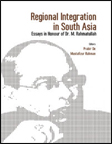 Regional Integration in South Asia: Essays in Honour of Dr. M. RahmatullahBuilding efficient transport linkages within and across countries in South Asia is crucial to development of production networks and value chains, and promotion of trade and investment. This collection of essays honors Dr. M. Rahmatullah, who championed the cause of multimodal connectivity in South Asia for seamless movement of goods across Asia, and dreamt of building an integrated South Asia through corridors and gateways to be connected with pan-Asian transport networks. A valuable resource for policymakers, academics, and practitioners working on issues of South Asian regional integration, this book looks at progress made on facilitating trade and enhancing connectivity in the region, assesses policy priorities, implementation imperatives, and emerging challenges to South Asian trade and integration, and gives recommendations on further strengthening South Asian integration. Author: Prabir De and Mustafizur Rahmant Year: 2016 Download Tags: Transport, Trade, Trade Facilitation, Connectivity, South Asia, South Asian Economic Union Improving Energy Efficiency in South AsiaThis paper examines areas where the efficiency of South Asian power systems could be significantly increased, such as the operation of thermal power plants and transmission systems. It also looks at ways to increase conservation by users through time-of-use electricity tariffs, appliance standards, and demand control through smart metering. It concludes that South Asia has a significant potential for energy efficiency improvement in the power sector, which can be realized by implementing policies and programs that can readily complement the existing institutional framework. Author: Priyantha Wijayatunga and Tilak Siyambalapitiya Year: 2016 Download Tags: Energy, ADB, South Asia, ADB RCI Trade, Testing and Toasters: Conformity Assessment Procedures and the TBT CommitteeDuplication, delays or discrimination in Conformity Assessment Procedures (CAPs) can significantly increase trade costs: this risk is reflected in the growing importance of CAPs in World Trade Organization (WTO) discussions, and bilateral and regional free trade agreements. The paper uses new data on government-to-government discussions of CAPs in the WTO Committee on Technical Barriers to Trade (TBT) and studies trade issues that WTO members encounter with CAPs, based on specific trade concerns raised during 2010-2014. Author: Devin McDaniels and Marianna Karttunen Year: 2016 Download Tags: Technical Barriers to Trade, WTO, Trade Disaster Risk Financing in BangladeshBangladesh is disaster-prone, with frequent severe floods and cyclones. Applying appropriate disaster risk financing is key to minimizing economic impacts from disasters, and sustaining the country’s development. This paper analyzes economic losses in Bangladesh caused by natural disasters from 2000 to 2013 and the funding gap, due in part to insufficient financial preparedness in disaster risk management. Author: Mayumi Ozaki Year: 2016 Download Tags: ADB, Bangladesh, South Asia Asia-Europe Connectivity Vision 2025: Challenges and OpportunitiesThe 11th Asia-Europe Meeting (ASEM) Summit held in Mongolia in 2016 saw ASEM member countries renew their commitments for deepened engagement between Asia and Europe. This report on the Summit provides ideas for an ASEM roadmap for connectivity, recognizing the need for sustainability and scalability. The report draws lessons from efforts by the Association of Southeast Asian Nations to bring together peoples, goods, services, and capital. ASEM, an intergovernmental forum for dialogue and cooperation, comprises 53 member countries, including India and Bangladesh. Author: Anita Prakash, editor Year: 2016 Download Tags: ASEAN, India, Bangladesh, Connectivity Reducing Trade Costs in LDCs: The Role of Aid for TradeThis report analyzes the role of Aid for Trade in reducing trade costs in least developed countries (LDCs), where trade costs are high and constitute a major impediment to the countries' participation in international trade. The most important sources of trade costs in LDCs are inadequate transport infrastructure, cumbersome border procedures, and compliance with non-tariff measures for merchandise exports. The study covers countries from around the world, including trade facilitation and trade restrictions in Nepal, Bhutan, India, and other Asian countries. Author: Rainer Lanz, Michael Roberts, Sainabou Taal Year: 2016 Download Tags: Trade, Trade Facilitation South Asian Approach to Sustainable Development Goals: Trade Insight Vol. 12, No. 1, 2016The paper, published by South Asia Watch on Trade, Economics and Environment, situates the challenges of implementation of the Sustainable Development Goals (SDGs) in the South Asian context. Noting that the delivery of the Millennium Development Goals in the region had been quite uneven, the paper examines the potential for regional cooperation to better achieve the SDGs. The paper then tries to chart a South Asian pathway for SDGs implementation and put forward some concrete proposals for South Asian countries. Author: Debapriya Bhattacharya and Umme Shefa Rezbana Year: 2016 Download Tags: ASEAN, India, Economic Integration Celebrating the Third Decade and Beyond: New Challenges to ASEAN-India Economic PartnershipThe relationship between ASEAN and India is set to deepen as ASEAN and India step up their collaboration across a range of economic and strategic issues, including trade and connectivity, culture, people-to-people links, trans-national terrorism, and maritime security. This book seeks to review the past and suggest ways to further strengthen economic partnership between ASEAN countries and India. It primarily deals with the economic integration issues between ASEAN and India, and assesses policy priorities, effectiveness, implementation imperatives and challenges. The book tries to capture essential features of cross-cutting issues and attempts to draw policy implications. Author: KW Publishers Year: 2016 Download Tags: ASEAN, India, Connectivity SARSO News: Vol. 2 No. 3The South Asian Regional Standards Organization (SARSO) newsletter features updates on SARSO events and activities. This issue highlights SARSO efforts to strengthen international relations, through its participation in the 39th International Organization for Standardization (ISO) meeting in Beijing, China, and related activities. The issue also features a meeting with the Asian Development Bank (ADB), where ADB briefed SARSO on the progress of diagnostic studies in South Asia Subregional Economic Cooperation (SASEC) member countries. Author: South Asian Regional Standards Organization Year: 2016 Download Tags: SARSO, ADB, SASEC 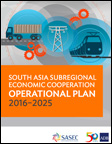 South Asia Subregional Economic Cooperation Operational Plan 2016-2025The SASEC Operational Plan 2016–2025 embodies the strategic objectives and operational priorities of the SASEC Program for the next decade. It expands the SASEC Program's focus beyond intraregional cooperation to developing links with Southeast and East Asia, thus widening the scope of transport, trade facilitation, and energy cooperation. Economic and industrial corridor development, which will arise from improved connectivity, has been introduced as a priority initiative. SASEC 2025 is supported by a list of potential projects to be implemented in the subregion during 2016-2025, that will advance the SASEC goals of multi-modal connectivity, energy security and the growth of regional energy markets, and increased intra- and inter-regional trade. An
update to the operational plan was
published in 2020. Author: Asian Development Bank Year: 2016 Download Tags: SASEC, ADB, Trade Facilitation, Economic Corridor, Transport, Myanmar The Little Data Book 2016The Little Data Book 2016 offers a quick reference of World Development Indicators 2016, presenting the latest available data for World Bank member countries and other economies in 214 tables. Regional and income group aggregates are also covered in the 12 summary tables, including South Asia. The book includes selected indicators used to monitor progress toward the Sustainable Development Goals. Author: World Bank Year: 2016 Download Tags: Sustainability, South Asia, Economic Growth 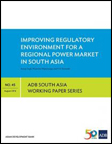 Improving Regulatory Environment for a Regional Power Market in South AsiaCountries in South Asia continue to experience poor access to energy, energy shortages, and concerns for energy security. Bilateral energy trading, with its limited scope, leaves untapped the vast economic, reliability, and environmental benefits of energy cooperation in the region. Improving access to modern energy sources through regional cooperation contributes toward economic growth, and better and more sustainable living conditions in South Asia. Regional energy cooperation supports the development of regional primary energy sources to generate electricity, cross-border transmission infrastructure, and a regional framework that will coordinate energy resource development and trade of electricity across the region. However, this will only be possible with appropriate policies and harmonized legal and regulatory frameworks in all necessary systems. Experience across the world indicates that such legal and regulatory changes can be accomplished successfully. Author: Anoop Singh, Priyantha Wijayatunga, and P. N. Fernando Year: 2016 Download Tags: Energy, Regional Cooperation, South Asia, ADB RCI 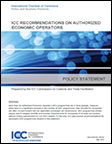 ICC Recommendations on Authorized Economic OperatorsThe World Customs Organization (WCO) developed the WCO Framework of Standards to Secure and Facilitate Global Trade (SAFE), of which the Authorized Economic Operator (AEO) program is an integral part, referring to manufacturers, importers, exporters, brokers, carriers, consolidators, intermediaries, ports, airports, terminal operators, integrated operators, warehouses, distributors, and others that have been approved by or on behalf of a national Customs administration as complying with WCO or equivalent supply chain security standards. AEO accreditation provides several benefits, including immediate release procedures self-assessment, and relief from guarantee/bond requirements. With AEO programs globally on the rise, the International Chamber of Commerce has put together several recommendations for successful AEO programs that lead to tangible benefits and process improvements for companies of all sizes and sectors, without limiting opportunities for non-AEO traders. Author: ICC Commission on Customs and Trade Facilitation Year: 2016 Download Tags: Customs, Trade Facilitation, WCO 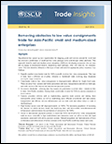 Removing Obstacles to Low Value Consignments (Trade Insights: Issue No. 18)Diffusion of digital technology and digitalization of products and services are allowing developing country small and medium-sized enterprises (SMEs)—which generate the majority of employment, especially in landlocked developing countries such as Nepal—to become globally competitive and participate in international trade. However, several barriers continue to hinder developing country SMEs to maximize benefits of cross-border digital trade. This publication recommends critical actions, including raising de-minimis thresholds; reducing Customs document requirements; developing low-cost and efficient transportation, delivery services, telecommunications and broadband networks; and establishing a legal framework that enhances conduct of online transactions. Additionally, neighbors in the region must coordinate and work together to build the required infrastructure, and to allow for mutual recognition or harmonization of systems, procedures, enforcement mechanisms and laws affecting digital trade. Author: Pascale Bourquin and Adam Heal Year: 2016 Download Tags: Small and Medium Enterprise, Nepal, ICT, Customs, Trade Facilitation SARSO News Volume 2, Issue 2The South Asian Regional Standards Organization (SARSO) newsletter features updates on SARSO events and activities. This issue highlights initiatives by SARSO to harmonize standards and improve conformity assessment in the region through workshops, and also meetings of its sectoral technical committees. It also discusses the Cooperation Agreement signed by SARSO and the International Organization for Standardization, to help facilitate the flow of goods and services, and participation of SARSO in a meeting organized by the private sector on 'Promoting Trade in Bangladesh-Bhutan-India-Nepal' region. Author: South Asian Regional Standards Organization Year: 2016 Download Tags: Standards, Trade Facilitation, SAARC, BBIN, South Asia 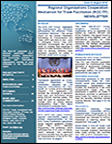 Regional Organizations Cooperation Mechanism for Trade Facilitation (ROC-TF) Newsletter: Issue X, August 2016This issue highlights the framework agreement on cross-border paperless trade facilitation adopted by the United Nations Regional Commission for Asia-Pacific, which will facilitate the exchange of electronic trade data and documents between participating United Nations Economic and Social Commission for Asia and the Pacific (UNESCAP) member states, and the 2016 Global Facilitation Partnership for Transportation and Trade forum. The latterencourages the private sector to mobilize expertise in support of trade facilitation reforms to develop effective trade facilitation solutions for small and medium-sized enterprises. The Newsletter also features SASEC-supported initiatives, including the launch of the new Maldives Customs Service training module on Customs valuation, as well as data collection for establishing the Trade and Transport Facilitation Monitoring baseline in Bhutan. The ROC-TF newsletter is a biannual publication featuring updates, publications and forthcoming activities of regional and international organizations working on trade facilitation in the Asia-Pacific region, including the Asian Development Bank, the World Customs Organization, and UNESCAP. Author: United Nations Economic and Social Commission for Asia and the Pacific Year: 2016 Download Tags: Trade Facilitation, ICT, Maldives, Customs, SASEC, Customs Valuation, Bhutan 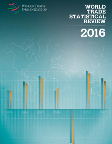 World Trade Statistical Review 2016The World Trade Statistical Review is the World Trade Organization's latest flagship publication offering a detailed analysis of the latest developments on global trade in goods and services—including developments in trade policy and participation of developing economies and least developed countries—examined through analytical chapters, complemented by over 50 tables. The publication reports that in 2015, developing Asia represented 67% of developing economies’ exports. In merchandise trade, India ranked 9th among the world's top exporter of agricultural products, and continues to be one of the top 3 textile exporters, which accounts for nearly 2/3s of world exports. A 25% decline in LDC exports was reported, due to the negative impact of the drop in fuel prices and mining products. LDC participation in global exports of commercial services also remained negligible at 0.8%. In trade policy making, the publication reported that WTO members introduced 132 measures to facilitate trade, yet applied 154 new trade-restrictive measures during the period between mid-October 2015 and mid-May 2016. Author: World Trade Organization Year: 2016 Download Tags: Trade, Export, India, Least Developed Countries 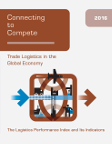 Connecting to CompeteConnecting to Compete scores and benchmarks countries’ performance on logistics, which is determined by various factors including infrastructure, regulations, policies, geography, and political economy. In the 2016 Logistics Performance Index (LPI), which measures the efficiency of international supply chains, the “logistics gap” between more and less developed countries remain evident. Among SASEC member countries, India is a top performing lower-middle-income economy, improving its rank from 54 in 2014 to 35 in 2016. Bangladesh is ranked 87, Maldives is ranked 104, Nepal is ranked 124, and Bhutan is ranked 135. The publication remarks that coastal countries score better than landlocked countries—a pattern clearly evident in South Asia—and notes that lack of integration in the region keeps the good logistics performance of India from improving the rankings of its neighbors. For countries at the bottom of the rankings, border management reforms continue to be a serious concern, as paperwork and long delays constrain trade efficiency. Author: Jean-François Arvis, Daniel Saslavsky, Lauri Ojala, Ben Shepherd, Christina Busch, Anasuya Raj, and Tapio Naula Year: 2016 Download Tags: Logistics, Business Efficiency, Trade Facilitation 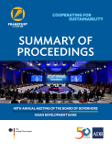 Summary of Proceedings of the 49th Annual Meeting of the Board of GovernorsThis publication provides a summary of the proceedings of the 49th Annual Meeting of the Asian Development Bank (ADB) Board of Governors, held in Frankfurt, Germany from 2-5 May 2016. It also includes statements from the Governors of ADB member countries, including SASEC countries. In his address, Mr. Abul Maal Muhith, Governor, Bangladesh, called for further acceleration of ADB's regional cooperation and integration strategy, which could play a critical role in accelerating economic growth, reducing poverty and economic disparity, and raising productivity and employment and environmental sustainability in Bangladesh, and lauded ADB's support in the signing of the landmark Bangladesh-Bhutan-India-Nepal Motor Vehicle Agreement (BBIN MVA). Mr. Arun Jaitley, Governor, India, highlighted India's strong and renewed commitment to regional cooperation in South Asia, which was demonstrated with the signing of the BBIN MVA and ongoing negotiations for the India-Myanmar-Thailand Highway. He also emphasized partnership between ADB and India in the development of the East Coast Economic Corridor, with initial focus on the ‘Vizag Chennai Industrial Corridor’, which will play a major role in connecting India to global production networks and value chains in the ASEAN region. Author: Asian Development Bank Year: 2016 Download Tags: ADB, Bangladesh, India, Regional Cooperation, Poverty Reduction Asian Development Outlook 2016 Supplement: Asia's Growth Prospects Undimmed by Brexit VoteRecent global developments have prompted revisions to developing Asia's 2016 and 2017 growth outlook, as published in March in Asian Development Outlook 2016 (ADO 2016). Uncertainty following the British vote to leave the European Union chilled already tepid recovery in the euro area. While developments have affected developing Asia’s currency and stock markets, its impact on the real economy in the short term is expected to be small. This Supplement expects the region to expand by 5.6% in 2016 and 5.7% in 2017. India has shrugged off global headwinds and is expected to grow by 7.4% in 2016 and 7.8% next year. South Asia as a whole will be the region’s fastest growing subregion. Author: Asian Development Bank Year: 2016 Download Tags: ADB, South Asia, Development The Little Green Data Book 2016The Sustainable Development Goals (SDGs) put environmental concerns on par with economic and social ones. The environment cuts across all the SDGs and is directly reflected in at least seven goals. The 2016 Little Green Data Book provides 50 indicators for 200 countries. Several indicators have the potential to measure progress on the SDGs as well as highlight important trends in the environment more broadly. The indicators are part of the larger World Development Indicators compiled annually by the World Bank from many different data sources. Author: World Bank Group Year: 2016 Download Tags: Energy, Environment, South Asia, WB Cleantech Start-ups Can Solve Climate ChangeThe Asian Development Bank (ADB), through its Climate Technology Finance Center, seeks to accelerate clean technology entrepreneurship and investment in Asia by supporting programs that aim to produce investable clean technology, risk capital for clean technology, technological knowledge, and a stronger clean technology ecosystem. This brochure gives a brief background on how ADB works with start-ups across Asia to promote more efficient management of energy and natural resources. Author: Asian Development Bank Year: 2016 Download Tags: ICT, Energy, Environment, India ASEAN-India Air Connectivity ReportAir connectivity plays an important component in India’s connectivity agenda with the Association of Southeast Asian Nations (ASEAN). This ASEAN-India Air Connectivity Report addresses issues and challenges concerning air connectivity between India and ASEAN, including constraints and bottlenecks hindering growth of air cargo that would help unlock trade potential. With India embarking on “Make in India” and “Skill India” policies, stronger air connectivity has become all the more important in the context of India’s drive for economic integration with its neighbors in the east. Author: ASEAN-India Centre and Research and Information Centre for Developing Countries Year: 2016 Download Tags: Transport, ASEAN, India, Manufacturing 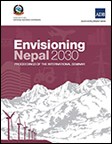 Envisioning Nepal 2030Nepal's National Planning Commission has undertaken the initiative to develop Nepal’s long term Development Strategy 2030 by engaging with international development experts, development partners, policy makers, and representatives of civil society organizations in the international seminar 'Envisioning Nepal 2030'. With the aim of serving as a guideline for Nepal’s graduation from Least Developed Country status by 2022, achieve the Sustainable Development Goals in the post-Millennium Development Goals era, and become a middle-income country by 2030, the seminar identified challenges and opportunities, and discussed how a fast-paced and sustainable inclusive growth could be achieved. In his opening remarks, Asian Development Bank Vice President Wencai Zhang, underscored the importance for Nepal to strategically position itself within a broader regional cooperation to transform itself from a landlocked into a landlinked country. Author: Nepal National Planning Commission Year: 2016 Download Tags: Nepal, Hydropower, Energy, Regional Cooperation Nepal Investment Guide 2016Nepal Investment Guide 2016 was published to provide information about investment opportunities in Nepal and the process of doing business. It identifies potential sectors for investment; relevant government agencies for foreign businesses; existing laws on labor, taxation, and imports and exports; special economic zones; and comparative benefits to investors. Author: Nepal Office of the Investment Board Year: 2016 Download Tags: Nepal, Import, Export, Investment Thirty Years of SAARC: Society, Culture and DevelopmentThis book traces economic and political issues through SAARC’s 30-year journey. The collection provides a well-researched assessment of SAARC, looks at policy directives for the future, and examines constraints to cooperation in South Asia. The publication argues that countries need to consider the benefits of economic cooperation if they wish to play an increased role in globalization. Author: Rajiv Kumar and Omita Goyal, editors Year: 2016 Download Tags: SAARC, Regional Cooperation, Development Towards a Sustainable Future: Energy Connectivity in Asia and the PacificDespite the benefits of energy connectivity, energy trade in Asia and the Pacific has remained far below its potential. This publication takes a detailed and engaging look at how smart region-wide energy connectivity could greatly improve energy supply and address the environmental impacts of energy. It maps existing energy connectivity in the region, examines ongoing initiatives, and suggests regional action plans that could lead Asia and the rest of the world to a sustainable future. Author: United Nations Economic and Social Commission for Asia and the Pacific Year: 2016 Download Tags: Asia-Pacific, Energy, Environment, Sustainability, Connectivity, UNESCAP Facilitating Trade between India and Sri LankaIndia and Sri Lanka have duty-free access to each other’s markets through the India-Sri Lanka Free Trade Agreement. Yet in recent years, traders from both countries have rarely utilized the agreement. This study aims to identify ways to improve importing and exporting under the agreement. It examines key issues and how to address them through the education of traders and Customs officials on goods eligible for concessions, facilitating testing and certification, streamlining Customs procedures, and establishing help desks. The study also offers recommendations in the areas of trade facilitation that may be incorporated in future negotiated agreements. Author: Suwendrani Jayaratne and Janaka Wijayasiri Year: 2016 Download Tags: Sri Lanka, India, Exports, Trade, Customs ADB 2015 Development Effectiveness ReviewThe Asian Development Bank (ADB) is committed to implementing reforms to reach its goals to be a bigger, faster, and stronger development institution. The 2015 Development Effectiveness Review is the annual performance report of the ADB. It tracks development progress in Asia and the Pacific and monitors ADB's effectiveness. The report also takes a look at rapid gains made by ADB developing member countries and examines the challenges that lie ahead. Planned reforms laid out in the book include those that tackle sustainability issues internally and in developing member countries. Author: Asian Development Bank Year: 2016 Download Tags: Development, Asia-Pacific, Poverty Reduction, ADB  Hydropower @ CrossroadsIndia has significant hydropower potential and can meet a demand of around 85 gigawatts, at 60% load factor. Increasing the country’s hydropower capacity could reduce generation costs and benefit both communities and industry. Hydropower also has the advantage of contributing very little to carbon emissions. However, only 41 gigawatts of hydropower capacity has been installed, accounting for only 28% of the total potential. Hydropower can play a crucial role in India’s sustainable development and energy needs given that it meets the criteria of sustainability, availability, reliability, and affordability. This publication provides recommendations that could be of use to policymakers and other interested parties. The book lays out the status of hydroelectric power in India and analyzes opportunities to increasing capacity. It provides recommendations with regard to market development, safeguard issues, financing, land acquisition, technical challenges, hydropower planning, and enabling infrastructure. Author: The Associated Chambers of Commerce of India and PricewaterhouseCoopers Year: 2016 Download Tags: Hydropower, Energy, India 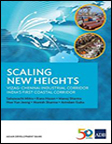 Scaling New Heights: Vizag-Chennai Industrial Corridor, India’s First Coastal CorridorThis book provides policymakers with a guide to understanding India’s economic corridor development strategy by examining its first coastal economic corridor, the East Coast Economic Corridor. It lays out the plan for its first phase, the Vizag–Chennai Industrial Corridor, which can help unify the country's domestic market, integrate its economy with Asia's global value chains, and support the 'Make in India' initiative to spur manufacturing through construction of world-class infrastructure supported by a major transport network, connecting urban clusters complemented by vibrant industrial zones, and encouraging a favorable and competitive environment for businesses to thrive, and facilitating efficient movement of goods and people. As a policy instrument and development strategy, economic corridors can help fast-track inclusive and sustainable economic growth, stimulate rapid industrialization and increase productivity, promote investments, and expand regional connectivity. Author: Sabyasachi Mitra, Rana Hasan, Manoj Sharma, Hoe Yun Jeong, Manish Sharma, and Arindam Guha Year: 2016 Download Tags: Economic Corridor, India, Trade Facilitation, Transport, Employment, Economic Corridor Development, ADB RCI 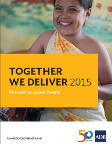 Together We Deliver 2015: Partnerships against PovertyThis book gathers 14 stories from across Asia and the Pacific that highlight successful projects demonstrating development impact, best practices, and innovation. It includes stories from Bangladesh, India, Nepal, and Sri Lanka that illustrate how the Asian Development Bank (ADB) and its partners, with their combined expertise, problem-solving abilities, and finances lift people’s living standards and solve a variety of pressing development problems. In India, Mumbai’s new Chhatrapati Shivaji International Airport is a shining example of how public–private partnerships can help solve the country's infrastructure deficit, increasing efficiency in cargo and passenger handling and saving on energy costs. In Bangladesh, partnership between ADB and nongovernment organizations is bringing health care to the urban poor. In Nepal, a Skills for Employment project is helping those caught in poverty improve their job prospects. In Sri Lanka, ADB and its development partners helped provide a fresh start through electricity, education, health services, and water sanitation.
Author: Asian Development Bank Year: 2016 Download Tags: Public Private Partnerships, Transport, Water Sanitation, Employment, Poverty Reduction ADB Annual Report 2015The Asian Development Bank's (ADB) 2015 Annual Report provides a complete picture of ADB’s performance in the reporting year. In 2015, South Asia became the fastest-growing regional economy in Asia and the Pacific, and ADB's assistance to the region approached $3.80 billion in combined loans and grants for 22 projects and $37.26 million in grants for technical assistance. Through the South Asia Subregional Economic Cooperation (SASEC) Program, ADB also continued to drive tighter integration in the region, enhancing cooperation and boosting connectivity with initiatives including helping finalize the Bangladesh-Bhutan-India-Nepal and India-Myanmar-Thailand Motor Vehicle Agreements, Bangladesh-India power grid upgradation, preparation of high-priority transport projects in Bangladesh, and analytical studies for India's East Coast Economic Corridor. Author: Asian Development Bank Year: 2016 Download Tags: ADB, SASEC, BBIN, Energy, Transport 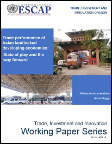 Trade Performance of Asian Landlocked Developing Economies: State of Play and the Way ForwardMany landlocked countries remain among the world's poorest nations, despite huge political, economic and technological gains over the last two centuries. Their lack of access to coast and sea ports burden them with higher trade costs, constraining their socio-economic development prospects. This paper examines the trade performance of Asian land-locked developing countries (LLDCs), including their export performance and export diversification, and attempts to identify factors affecting their performance, such as cost of trade and trade facilitation measures, which inhibit their integration into global and regional economies. Among LLDCs in South Asia, Bhutan incurs some of the highest trade costs and Nepal faces high cost in transport services. The paper finds persistent challenges to the growth of Asian LLDCs--trade barriers and trade restrictions, lack of infrastructure and poor trade facilitation performance-- and recommends reforms that could mitigate these continuing economic challenges. Author: Witada Anukoonwattaka and Aman Saggu Year: 2016 Download Tags: Landlocked Developing Countries, Exports, Trade, UNESCAP 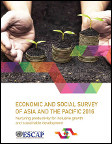 Economic and Social Survey of Asia and the Pacific 2016The 2016 edition of UNESCAP’s Economic and Social Survey of Asia and the Pacific encourages the region to rethink its development strategy. As 2016 marks the beginning of the 2030 Agenda for Sustainable development, the period is also characterized by an outlook clouded by uncertainty, with growth expected to plateau at about 5% in 2016 and 2017. Exports bound for developed economies continue to move sluggishly and domestic demand remain moderate. Thus, to bolster economic growth, the Survey recommends adopting a development model that raises domestic and regional demand. Along with active labor market policies and greater social protection, regional economic cooperation and integration--in areas covering capital markets, intraregional trade, infrastructure development, and energy and information and communications technology (ICT) connectivity--can be an important avenue for boosting domestic and regional demand. Author: United Nations Economic and Social Commission for Asia and the Pacific Year: 2016 Download Tags: Economic Growth, Regional Cooperation, ICT, Energy Asian Development Outlook 2016: Asia’s Potential GrowthThe Asian Development Outlook 2016 forecasts 5.7% growth for developing Asia in 2016 and 2017. It projects that South Asia will post the most rapid growth in developing Asia, with growth in the subregion accelerating to 7% in 2015, and will accelerate further to 7.3% in 2017 after a slight dip to 6.9% in 2016. India's growth is expected to undergo a slight slowdown to 7.4% in 2016 as exports decline and both public and private investment slows, but rebound to 7.8% in 2017 as the business environment improves, and exports and investment recover. Bangladesh will also see continued moderate growth, resulting from sustained progress toward macroeconomic and structural reform. Author: Asian Development Bank Year: 2016 Download Tags: Asia, India, Bangladesh, Economic Growth, Development, ADB 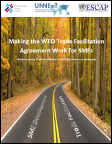 Making the WTO Trade Facilitation Agreement Work for SMEsSmall and Medium Enterprises (SMEs) comprise 95% of enterprises worldwide and provides at least two thirds of private sector employment. However, when it comes to international trade, SMEs experience limited capacity in dealing with the complex administrative and regulatory procedures associated with moving and selling goods across borders. This book fills a gap by providing a reference for articles of the World Trade Organization (WTO) Trade Facilitation Agreement (TFA) that are particularly beneficial to SMEs, and identifies examples of SME-specific programs, measures and interventions that can support the implementation of such provisions. It proposes mainstreaming relevant elements of the WTO TFA in existing SME policies and initiatives, to ensure that it contributes toward internationalization of SMEs.
Author: UNESCAP, UNNExT, and ITC Year: 2016 Download Tags: Small and Medium Enterprise, Trade Facilitation, Trade, UNESCAP, Small and Medium Enterprises, India, Nepal Information and Communication Technologies for Trade and Transport FacilitationInformation and Communication Technologies (ICT) provides efficiencies that can deliver many advantages for trade and transport facilitation (TTF) including Single Windows, automated business processes, digitalization of procedures, simpler interaction and transmission of data, and faster decision-making abilities. This paper looks at the business needs of TTF and explains the requirements of an architectural model to support TTF, with policy makers in mind. It highlights the need to integrate and modernize ICT systems and architecture so that ICT can respond to the needs of trade and transport facilitation. Author: UNESCAP and UNNExT Year: 2016 Download Tags: ICT, Trade Facilitation, Transport Facilitation, Single Window, UNESCAP Innovation Networks and the New Asian RegionalismAsian development and the strengthening of regional cooperation and integration (RCI) worldwide will experience the effects of growing structural reform issues, such as slowing productivity growth, increasing economic inequalities and systemic vulnerabilities. Hence, future RCI policies will need to complement domestic policy reform. This book examines factors that drive the regional economic integration of nations, and explains how beneficial integration can generate broad-based, equitable wealth in Asia. Author: Hans-Peter Brunner Year: 2016 Download Tags: Regional Integration, Regional Cooperation, Economic Integration 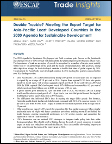 Double Trouble? Meeting the Export Target for Asia-Pacific Least Developed Countries in the 2030 Agenda for Sustainable Development (Trade Insights: Issue No. 15)This paper evaluates the prospects of least developed countries (LDCs) in Asia-Pacific in meeting the target set for LDCs to double their share of global exports by 2020, in Goal 17 of the Sustainable Development Goals (SDG). The paper notes that most Asia-Pacific LDCs have reported strong GDP growth turnout in recent years and are expected to grow by an average of 5.8% in 2016; difficulties faced by individual LDCs vary – Nepal, as an example, would need expansion at the average rate of 19% per year; LDCs can use national SDG strategies and go for longer-term goals—beyond the goals of export expansion—such as aiming to reach targets on trade cost reductions and trade facilitation. Author: Adam Heal, Miso Kim, Juliette Perche, Rajan Sudesh Ratna, and Pakkaporn Visetsilpanon Year: 2016 Download Tags: Least Developed Countries, Exports, Trade Facilitation, Trade, UNESCAP 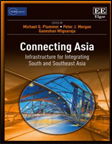 Connecting Asia: Infrastructure for Integrating South and Southeast AsiaThis book contains background papers prepared for the Asian Development Bank and the Asian Development Bank Institute joint study, 'Connecting South Asia and Southeast Asia.' It emphasizes the potential contribution to growth that greater connectivity—through better transport and energy infrastructure and improved soft infrastructure, including trade facilitation—between South Asia and Southeast Asia can foster. With benefits including greater participation in global supply chains for South Asia; lower trade costs; and increase in inter- and intraregional trade, the book underscores that, at a juncture where closer regional integration can secure sustainable and inclusive growth for economies in the two regions, specific policies should be examined and considered to enable both regions to maximize gains from greater integration. Author: Michael G. Plummer, Peter J. Morgan, Ganeshan Wignaraja, eds. Year: 2016 Download Tags: South Asia, Southeast Asia, Trade Facilitation, Transport, Energy, ADB, Economic Corridor, Bangladesh, India, Sri Lanka, ADB RCI 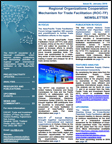 Regional Organizations Cooperation Mechanism for Trade Facilitation, Issue IX, January 2016This biannual publication features updates, publications and forthcoming activities of regional and international organizations working on trade facilitation in the Asia-Pacific region, including the Asian Development Bank (ADB), the World Customs Organization (WCO), and the United Nations Economic and Social Commission for Asia and the Pacific. It includes highlights of the Asia Pacific Trade Facilitation Forum 2015 and the Train-the-Trainer Workshops on Customs Valuation through Post Clearance Audit being jointly implemented by the WCO and ADB in the 6 SASEC member countries. This issue also features an analysis on achieving seamless supply chains through implementing comprehensive and pragmatic national trade facilitation reform programs. Author: UNESCAP Year: 2016 Download Tags: Trade Facilitation, Asia-Pacific, WCO, ADB, UNESCAP, Customs Valuation, Nepal, Bangladesh, Bhutan, India, Maldives, Sri Lanka 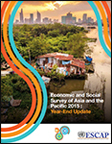 Economic and Social Survey of Asia and the Pacific 2015: Year-end UpdateThis year-end update revises economic growth in developing economies in Asia and the Pacific to 4.5% in 2015, from earlier projections of 4.9%, and updates the economic growth forecast for 2016 to 5%, from 5.2%. In most developing economies, including South and South West Asia, private consumption will lead to a slight pick-up in economic growth in 2016, amid gradual fiscal tightening and weak exports. With less robust growth compared to the years before and immediately after the global financial and economic crisis that started in 2008, the report highlights a need to tap into domestic and regional sources of demand—alternatives to dependence on external demand—including boosting investment in infrastructure, small and medium-sized enterprises, and the agricultural sector. Promotion of labor participation among the youth and the female population in South and South West Asia is also encouraged, since evidence has shown that improving their job opportunities matters for economic growth. Author: UNESCAP Year: 2016 Download Tags: Economic Growth, Gender, Infrastructure, UNESCAP |



